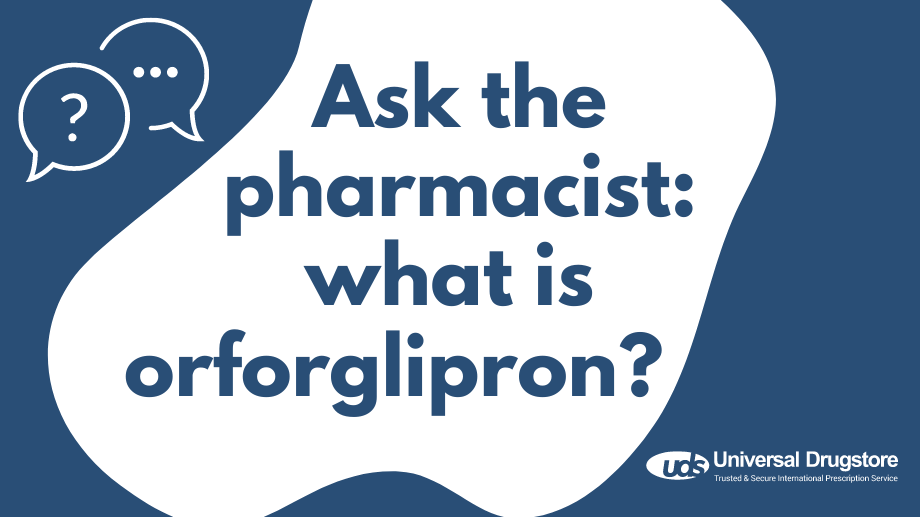What is orforglipron?

Obesity is a major risk factor for some of the leading causes of death worldwide. Glucagon-like peptide-1 or GLP-1 antagonists have seen their popularity rise in the last few years in the treatment of obesity and type 2 diabetes mellitus (T2DM). This has led to shortages of Novo Nordisk’s Ozempic (semaglutide) and Wegovy (semaglutide) and now drug companies scrambling to get new products to the market.
Eli Lilly and Company is one of these healthcare companies. They already produce Mounjaro (tirzepatide), an injectable dual GIP/GLP-1 receptor agonist that is used lower blood sugar levels in people with T2DM. It is currently in phase 3 clinical trials for weight loss but has not been approved by the FDA for this condition.
Eli Lilly also has 2 new drugs in clinical trials that could be game-changers for the industry. Retatrutide is a once-weekly injection given under your skin that is being studied to treat obesity. Early results show a mid-to-high 20% weight reduction and have proven very effective at dissolving liver fat.
Eli Lilly also has oral orforglipron in clinical trials. It is a once-daily medication for weight loss and T2DM. It has advantages over medications like Pfizer’s experimental drug danuglipron, although orforglipron might be the last to hit the market. Orforglipron is an oral GLP-1 medication so it is easier to make and typically is cheaper than its injectable counterparts.
So how does orforglipron help treat diabetes and obesity, and what other information should you know about this experimental medication?
Orforglipron FAQs
What will orforglipron be used for?
While still in clinical trials, results from two trials were presented at the 83rd Scientific Sessions of the American Diabetes Association in June. They showed that orforglipron to effective as both a weight loss treatment and one that can help manage blood glucose levels in people with T2DM.
Prior studies strongly also recommend the use of GLP-1 receptor agonists such as orforglipron in people with chronic kidney disease (CKD) and T2DM to reduce their risk of cardiovascular (heart) disease.
How effective is orforglipron?
While being studied for chronic weight management, results from phase 2 trials of orforglipron showed an average decrease in body weight of up to 14.7% from their baseline weight after 26 weeks. To be part of this study, patients had to between 18-75 years old with a be body mass index (BMI) of 30 kg/m^2 or more or a BMI of 27 kg/m^2 or more with at least one weight-related medical condition such as high blood pressure, high cholesterol, obstructive sleep apnea, or heart disease.
The study for its use in treating T2DM was also very positive. The phase 2 trial showed an average decrease in hemoglobin A1C (HbA1c) of up to 2.1% after 26 weeks. To be included in this trial, patients had to be 18 years of age or older with T2DM and an HbA1c of between 7.0% to 10.5%, and a BMI of at least 23 kg/m^2.
The participants in these trials combined orforglipron with a healthy diet and regular exercise.
How does orforglipron work?
Orforglipron is a non-peptide GLP-1 receptor agonist. GLP-1 is an incretin hormone your body makes in response to food. When GLP-1 receptors are activated, they increase the amount of insulin released by your pancreas while also decreasing the amount of stored sugar released from your liver. This helps lower your blood sugar levels.
Orforglipron also slows down how fast food travels through your digestive tract. This helps you feel fuller for longer and eat less, which can lead to weight loss.
What are the side effects of orforglipron?
The most common adverse events of orforglipron seen in clinical trials when compared to the placebo group were mild to moderate and GI-related. They included nausea, vomiting, diarrhea, stomach pain, and constipation.
When will orforglipron be on the market?
Eli Lilly began phase 3 trials to further study the safety and effectiveness of orforglipron for the treatment of obesity and T2DM in June 2023. It is not known if and when it will be approved by the FDA and brought to the market.
Related Medications
- Wegovy (semaglutide)
- Rybelsus (semaglutide)
- Mounjaro (tirzepatide)
- Saxenda (liraglutide)
- Victoza (liraglutide)
- Trulicity (dulaglutide)
Sources
- The New England Journal of Medicine: https://www.nejm.org/doi/full/10.1056/NEJMoa2302392
- HCP Live: https://www.hcplive.com/view/orforglipron-shows-promise-as-weight-loss-diabetes-agent-in-phase-2-trials
- Pubmed: https://pubmed.ncbi.nlm.nih.gov/37264711/
- Reuters: https://www.reuters.com/business/healthcare-pharmaceuticals/experimental-lilly-pill-leads-147-weight-loss-mid-stage-trial-2023-06-23/
- Medscape: https://www.medscape.com/viewarticle/993667